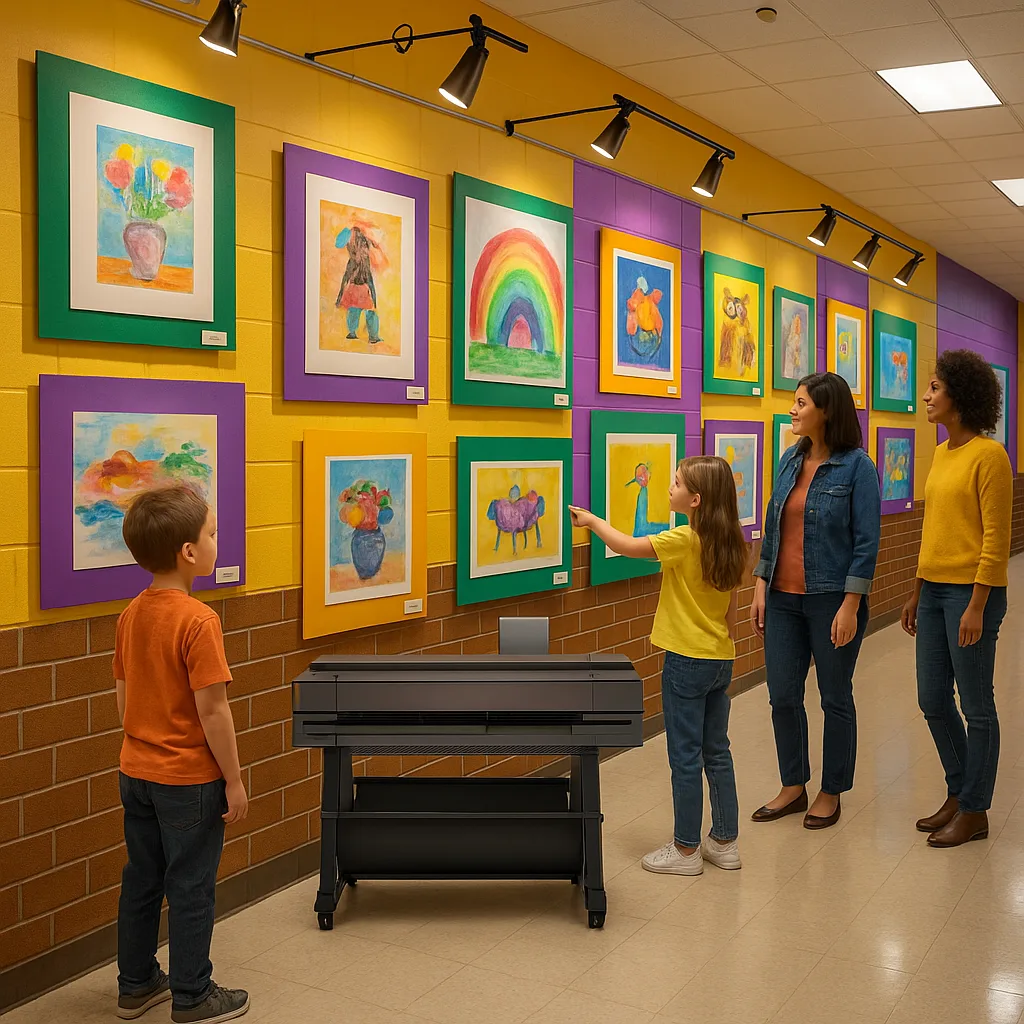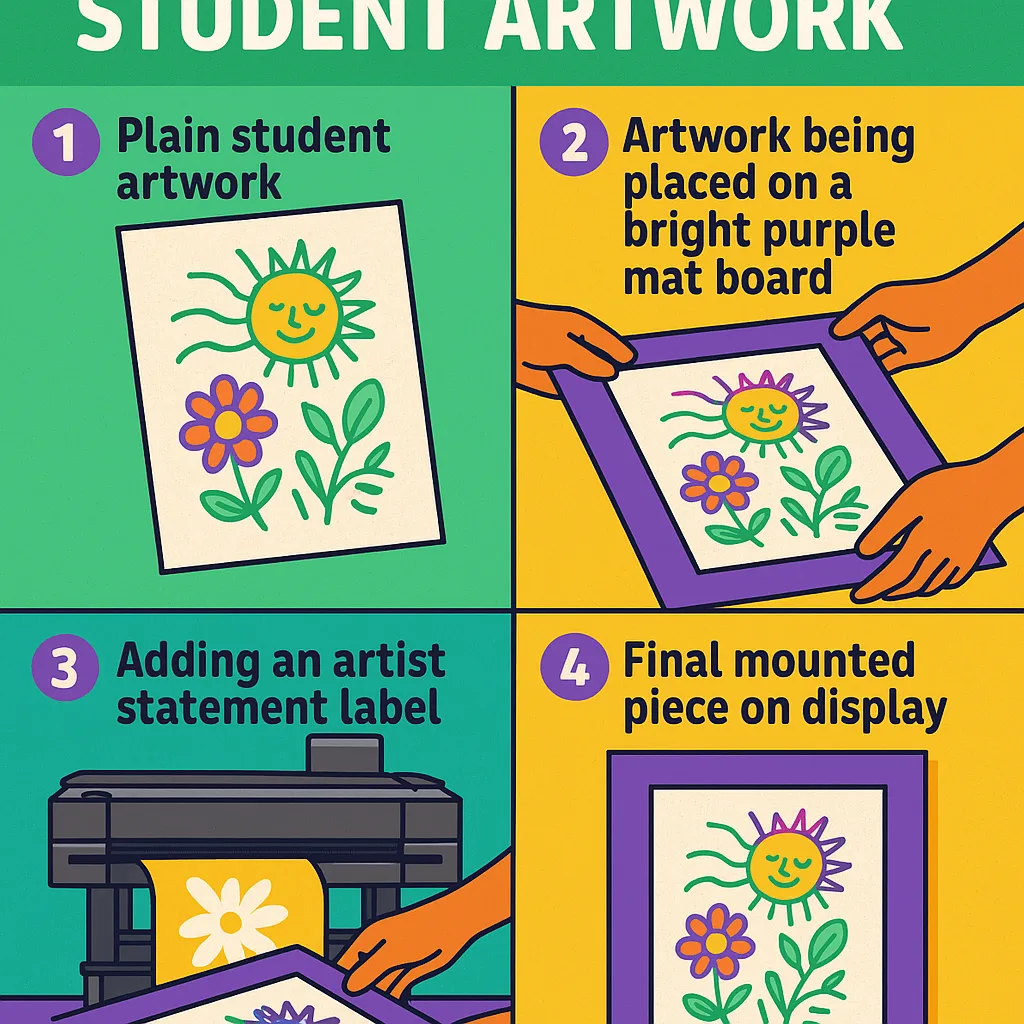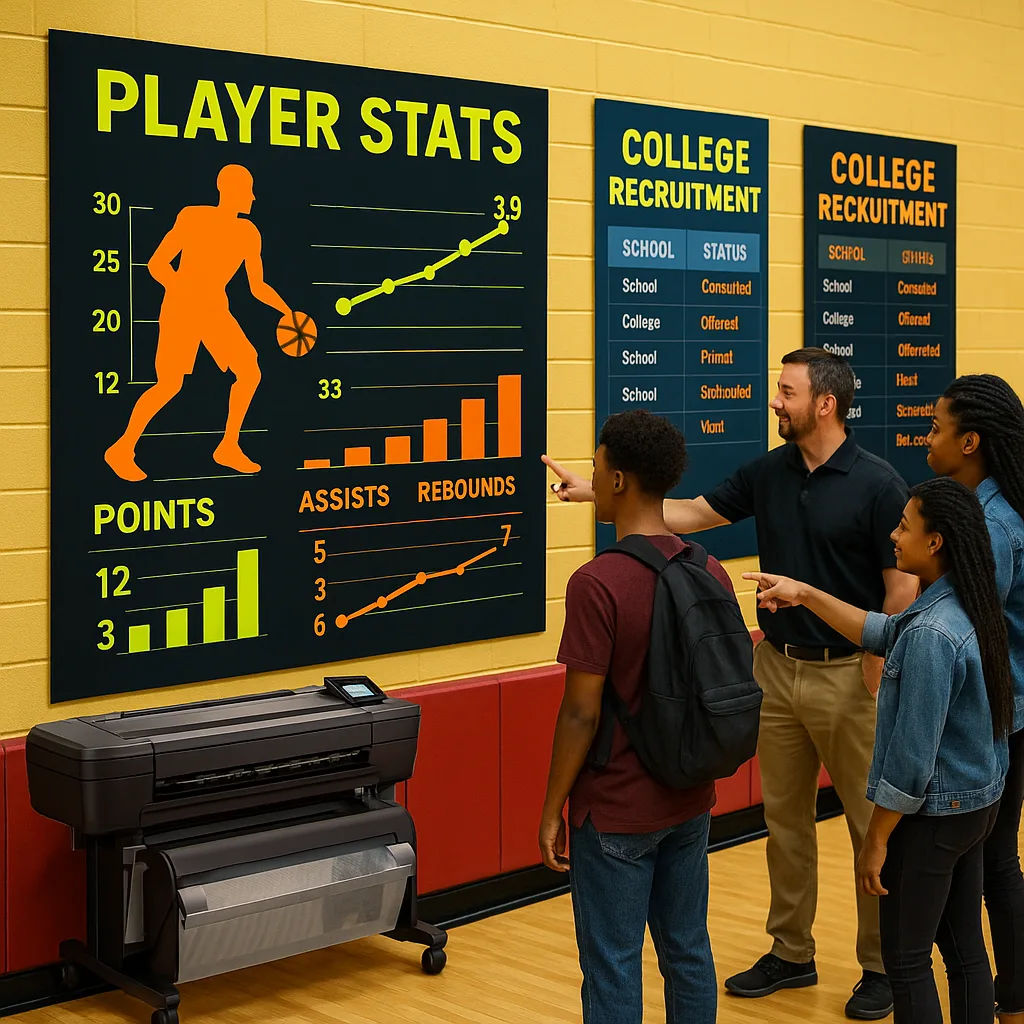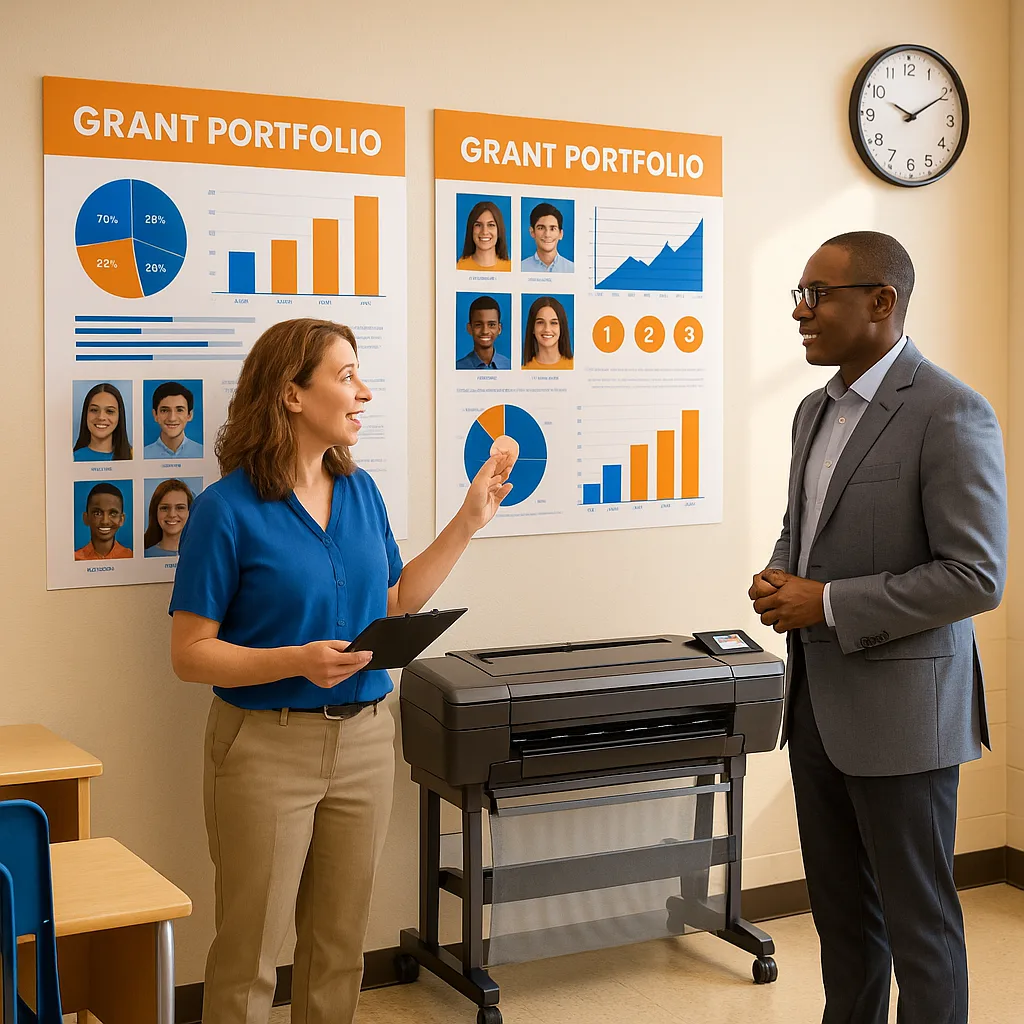
Picture this: A kindergartener’s watercolor masterpiece hangs alongside a fifth grader’s detailed pencil sketch, both illuminated equally, both celebrated entirely. That’s the magic that happens when you transform ordinary school hallways into professional art galleries. Whether you’re working with a limited budget or dreaming big, creating gallery-quality displays doesn’t require expensive frames or fancy equipment—just a bit of creativity and the right poster printer machine elementary art solutions.
Setting the Stage: Poster Printer Machine Elementary Art Galleries
Last spring, I watched a second-grader named Maya stand transfixed in front of our hallway gallery. Her collage—a burst of torn magazine pieces forming a sunset—hung between two other students’ work, all mounted on vibrant backgrounds we’d printed using our Education Express 24″ Poster Maker Package A. Maya tugged her mom’s sleeve: “That’s mine! Right there in the middle!”
Creating an elementary art show isn’t just about displaying artwork. Furthermore, it’s about building confidence, celebrating effort, and showing every child their creativity matters. Research from the National Art Education Association reveals that students who see their work professionally displayed show 40% higher engagement in subsequent art projects. Additionally, parent involvement increases by 65% when schools create gallery-style exhibitions.
Yet many of us struggle with the logistics. How do you mount 500+ pieces without breaking the budget? Therefore, let’s explore proven strategies that transform chaotic hallways into curated galleries that rival professional spaces.

The Foundation: Planning Your Gallery Layout
Before diving into mounting techniques, successful art shows start with intentional planning. First, measure your available wall space and divide it by your total number of students. This simple calculation ensures equity—every artist gets equal real estate.
Professional galleries follow the “57-inch rule”—artwork centers should align at 57 inches from the floor, average human eye level. However, elementary schools need flexibility. I create three horizontal zones: kindergarten-first grade at 40 inches, second-third at 48 inches, and fourth-fifth at 56 inches. Consequently, younger students can admire their peers’ work at comfortable heights.
Map your traffic flow next. High-traffic intersections need durable displays that withstand backpack bumps and curious fingers. Meanwhile, quieter alcoves can showcase delicate 3D pieces or interactive elements. Using Coated Poster Paper for mounting boards provides water-resistant protection in these busy zones.
Budget-Smart Mounting Solutions
Traditional matting costs $15-30 per piece—impossible when displaying 25+ students’ work per class. Instead, I discovered that poster printer cost becomes surprisingly economical when creating custom mat effects digitally.
Here’s my go-to technique: Design colorful borders in your poster software, leaving center windows for artwork. Print these on 24″ rolls, creating 20 custom mats for under $30 total. Students help choose border colors that complement their pieces, turning mounting into a collaborative lesson about color relationships.
For 3D elements or heavier pieces, create shadow boxes using printed backgrounds. The depth adds professional polish while keeping costs minimal. Our lifetime design service helps create templates you’ll reuse yearly, maximizing your investment.
Artist Statements: Giving Voice to Young Creators
Professional galleries always include artist statements—why shouldn’t elementary shows? These brief descriptions transform simple displays into meaningful narratives. Moreover, they develop critical thinking and writing skills across curricula.
I provide age-appropriate templates:
• K-1: “I made this because…” (dictated to adults)
• 2-3: Three sentences about process, materials, and inspiration
• 4-5: Paragraph format including artistic choices and challenges overcome
Print statements on cardstock using your poster printer machine for schools, creating unified, professional labels. Include the artist’s first name, grade, and title in kid-friendly fonts. Position these at child height—remember, your primary audience reads at 40-56 inches!
One powerful addition: QR codes linking to video artist talks. Students record 30-second explanations on tablets, and parents scan to hear their child’s creative process. Subsequently, shy students who struggle with writing can still share their artistic vision.
Lighting Magic on a Shoestring Budget
Proper lighting transforms good displays into breathtaking galleries. While we can’t install track lighting in every hallway, creative solutions exist. Battery-operated LED spotlights ($12-15 each) clip onto ceiling tiles, creating dramatic focal points for featured pieces.
For broader illumination, replace harsh fluorescents with daylight-balanced bulbs in existing fixtures. The color temperature shift—from yellowish 3000K to natural 5000K—makes colors pop authentically. Additionally, these bulbs reduce eye strain during gallery walks.
Strategic placement matters too. Angle lights at 30 degrees to minimize glare on glossy pieces. Then position them to avoid casting shadows from viewers. I learned this after watching kindergarteners inadvertently block light while admiring friends’ work!
Pro tip: Create “light catchers” by mounting metallic or white poster boards at angles above displays. These reflect ambient light downward, brightening artwork without additional fixtures. Your poster printer cost includes these reflectors when you plan material usage wisely.
Material Magic
Transform basic supplies into gallery-worthy displaysSmart Solutions
Use poster printer machine elementary art templates to create consistent, professional mounting boards. Mix matte and glossy finishes for visual interest!Space Solutions
Maximize every inch of display areaCreative Layouts
Create vertical galleries using floor-to-ceiling displays. Suspend lightweight pieces from fishing line for floating effects!Tech Integration
Blend traditional and modern display methodsDigital Elements
Add QR codes linking to process videos or digital portfolios. Parents love seeing artistic growth over time!Installation Day: Orchestrating Organized Chaos
Art show installation resembles choreographed chaos—500 pieces, excited students, and one day to transform hallways. Success requires military precision mixed with creative flexibility. Here’s my proven timeline that prevents meltdowns (yours and theirs).
Two weeks prior, I print all mounting boards using our Education Studio 24″ Package A+. Its dual-roll capability means printing colorful mats while simultaneously creating artist labels—a massive time-saver. Meanwhile, students write and revise artist statements during language arts blocks.
Installation morning starts at 6 AM. First, maintenance staff helps position ladders and cover floors. Parent volunteers arrive at 7 AM for “mounting brigade” training. Subsequently, we establish stations: artwork attachment, label printing, and wall mounting. Each team of three handles one grade level’s display.
By 8:30 AM, as students enter, major sections are complete. Throughout the day, classes take “gallery walks” to see progress. This builds anticipation while allowing real-time adjustments. Therefore, afternoon art classes help with final touches—straightening frames and adding finishing elements.
Opening Night: Creating Memorable Experiences
Transform your art show opening from a casual walk-through into an unforgettable celebration. Send printed invitations (yes, printed!) featuring student artwork. The tactile element shows you value this event beyond a digital announcement.
Create a red carpet entrance using a roll of red poster paper—poster printer cost for 25 feet is under $10, but the photo opportunities are priceless. Station fifth-grade “docents” throughout galleries, trained to discuss displayed techniques and artistic elements.
Incorporate interactive elements that engage all senses. Play soft classical music to establish gallery ambiance. Furthermore, provide clipboards with “gallery guides” where visitors note favorite pieces and positive comments. Students treasure reading these afterward.
Set up a “future artists” station where younger siblings create mini-masterpieces while families browse. This prevents restlessness and includes everyone in the creative celebration. Print take-home coloring sheets featuring student artwork—turning admirers into participants.
Sustaining Excellence: Year-Round Gallery Management
Creating one spectacular show is wonderful—maintaining gallery-quality displays year-round impacts learning exponentially. Studies from Arts Education Partnership show continuous display of student work increases artistic risk-taking by 73%. Therefore, develop systems supporting ongoing excellence.
Rotate displays monthly, featuring different grades or themes. January might showcase winter-inspired pieces, while March celebrates texture explorations. This prevents hallway blindness where familiar displays become invisible. Additionally, frequent changes give more students spotlight opportunities.
Document everything through photography. Create digital portfolios showing each child’s artistic growth across years. When fifth graders graduate, present printed compilations of their K-5 artistic journey. Parents treasure these personalized books, and students see their creative evolution.
Invest in proper storage solutions. Flat files or large portfolios protect artwork awaiting display or returning home. Label clearly by class and date. Consequently, you’ll avoid frantic searches for specific pieces during parent conferences or portfolio reviews.
Consider establishing an “Artist of the Month” program. Feature one student’s collection in a prominent location, complete with artist photo and extended statement. Rotate through all students yearly, ensuring everyone receives individual recognition.
Breaking Down Poster Printer Machine Elementary Art Costs
Let’s address the budget elephant: How much does professional display really cost? Traditional framing runs $30-100 per piece—impossible for displaying 500+ artworks. However, smart planning with a poster printer machine for schools changes everything.
Initial investment in quality equipment pays dividends quickly. Our comprehensive packages include everything needed: printer, supplies, software, and lifetime design support. When you calculate poster printer cost per display, it averages $1.30-1.50 per mounted piece—including colorful mats and labels.
Compare this to outsourcing: Local print shops charge $15-25 per mounted poster, plus you lose creative control and face delays. Meanwhile, in-house printing allows last-minute additions and immediate replacements for damaged displays.
Beyond direct savings, consider hidden benefits. Students creating exhibition materials during art class learn practical skills. Parent volunteers gain investment in the process. Most importantly, you’re building sustainable systems supporting creativity for years.
Want specific numbers for your situation? Request customized pricing based on your school’s size and display goals. Remember, grants often cover art program equipment—we’ll help identify funding sources!
Your Gallery Transformation Starts Today
Every masterpiece deserves a frame, every young artist deserves recognition, and every school hallway holds potential for transformation. Whether you’re displaying kindergarten fingerpainting or fifth-grade portraits, professional presentation elevates student work from “cute” to compelling.
Start small if needed—transform one hallway section using techniques shared here. Watch how students respond when their creations receive gallery treatment. Notice parent reactions during conferences. Subsequently, momentum builds naturally as success spreads.
Remember Maya, standing proudly before her displayed collage? That moment of recognition ripples outward, inspiring continued creativity and building lifelong confidence. Your poster printer machine elementary art investment creates thousands of such moments yearly.
Ready to revolutionize your school’s visual culture? Snap photos of your current displays, then imagine them transformed with professional mounting, thoughtful lighting, and museum-quality presentation. The journey from bulletin board to gallery begins with a single decision: treating student creativity with the respect it deserves.







